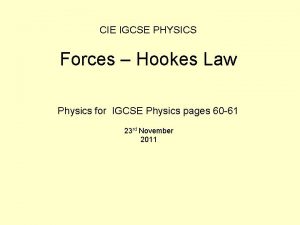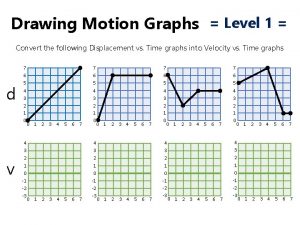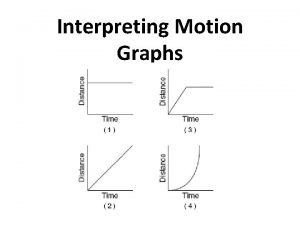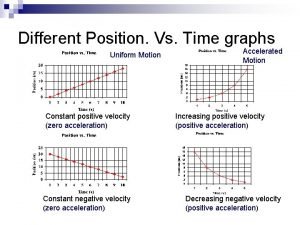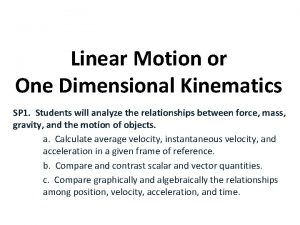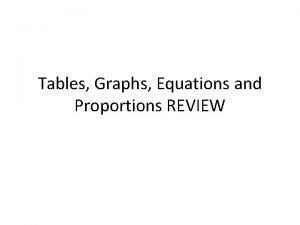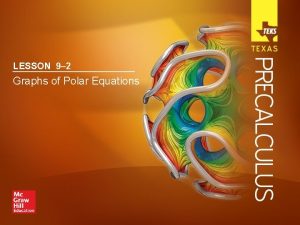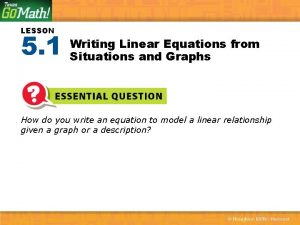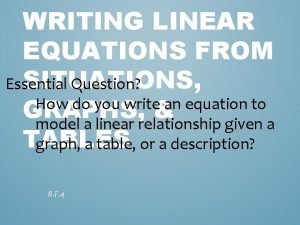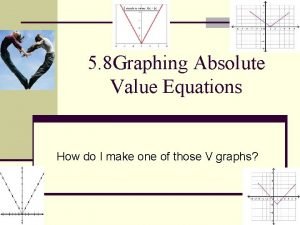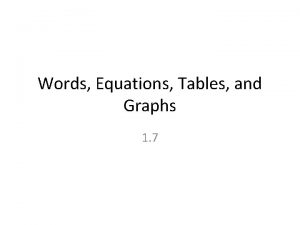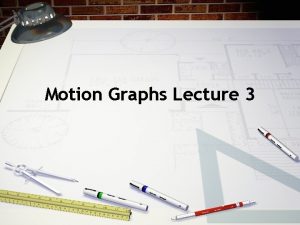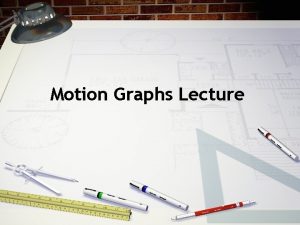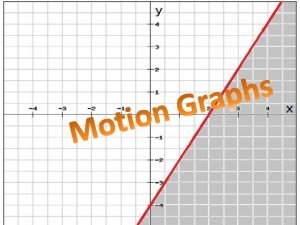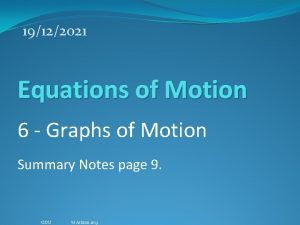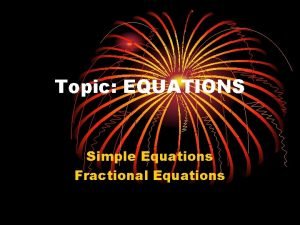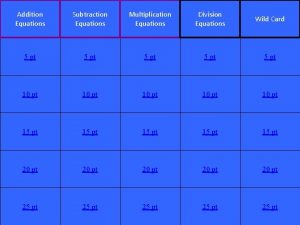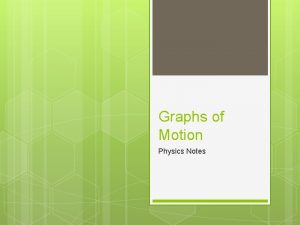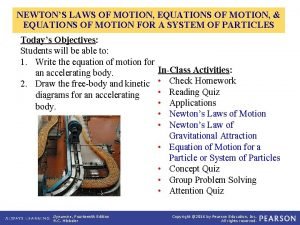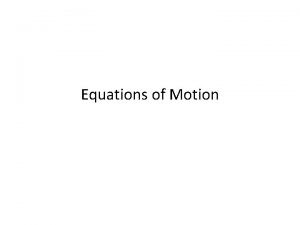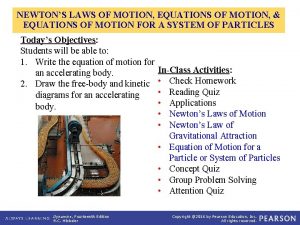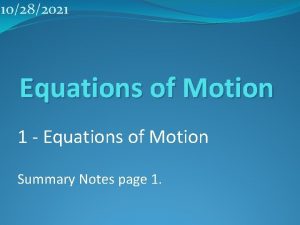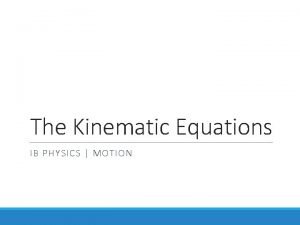Equations Graphs of Motion Cf E Higher Physics



















- Slides: 19

Equations & Graphs of Motion Cf. E Higher Physics

Symbols and units �The following quantites are used in equations of motion calculations…. . displacement, initial velocity, final velocity, acceleration, time �Can you state the symbol and unit for them all? Quantity displacement initial velocity final velocity acceleration time symbol unit abbreviation

Symbols and units �The following quantites are used in equations of motion calculations. �Here they are with the symbol, unit and abbreviation for each…. . Quantity symbol unit abbreviation displacement s metres m initial velocity u metres per second m s-1 final velocity v metres per second m s-1 acceleration a metres per second squared m s-2 time t seconds s You may hear equations of motions questions being called “suvat” or “tuvas” questions. This is because of the 5 quantities in these questions.

Revision from N 5 � At Nat 5 Physics we studied motion and in particular the displacement, velocity and acceleration of an object. � In Higher Physics we will derive some new powerful equations of motion in addition to those we have already met. � These equations will allow us to predict and analyse to motion of objects in space and time. Think about this example: A ball is dropped from a balcony. It hits the ground 1. 06 s later. Determine the height of the balcony. (How would we solve this in a N 5 class? ) Distance gone = area under velocity time graph

N 5 solution A ball is dropped from a balcony. It hits the ground 1. 06 s later. Determine the height of the balcony. Firstly determine the final speed of the ball as it hits the ground Then sketch a velocity time graph Velocity (ms-1) 10. 4 Then work out the area under the graph = ½ x b x h = 0. 5 x 1. 06 x 10. 4 = 5. 5 1. 06 time (s) Height of the balcony = 5. 5 m Surely there is a quicker way of doing this…. . there is!

Derivation of equations of motion �We can derive 3 new equations of motion. They are all based on the fact that…. and Displacement = area under a velocity time graph Equation 1. Simply rearrange the acceleration equation:

Equation of motion……. 2 Displacement is found by finding the area under this graph Velocity (ms-1) In this case the green rectangle + the blue triangle s = (area 1) + (area 2) s = (u x t) + ( ½ (v-u) t) s = (ut) + ½(at) t s = ut + ½ at 2 t time (s)

examples 1. A ball is dropped from a balcony. It lands 1. 06 seconds later. Calculate the height of the balcony 2. A stone is dropped down a well. It lands 4 s later. How deep is the well? 3. A car accelerates from rest with a constant acceleration of 4. 2 ms-2. Calculate the time taken for it to cover a distance of 100 metres. 4. A ball is thrown vertically down a well 32 m deep. It hits the bottom 2. 1 seconds later. What was the initial speed that the ball was thrown at? 1. ) 5. 5 m 2. ) 78. 4 m 3. ) 6. 9 seconds 4. ) 5 ms-1

Equation of motion ……. 3 Square the 1 st equation of motion. Example: A diver drops from a cliff 55. 0 metres high. Calculate his velocity as he hits the water. (assuming a = g = 9. 8 ms-2) (This is 73 mph!)

Equation of motion…… 4 �There is a 4 th equation of motion that is basically just “displacement = average velocity x time” Average velocity = (initial velocity + final velocity) /2 Example: The Tesla Roadster goes from 0 – 60 mph (26. 8 ms-1) in 1. 90 s. Calculate the distance gone in this time. (car is travelling in a straight line so distance = displacement) s = (0 + 26. 8)/2 x 1. 9 s = 25. 5 m

Measuring Acceleration Double card *Note: The TSA computer calculates the velocity of each card using: • A “double card” is placed on the trolley. • The trolley accelerates down the slope and passes through the light gate connected to a TSA computer which is set to measure acceleration The TSA computer calculates acceleration by using: u = velocity of first card * v= velocity of second card * t = time between the 2 cards

Graphs of Motion We met graphs of motion in N 5 You should remember that: Acceleration = gradient of the graph Displacement = “area under the graph” We can extend this now at Higher Physics and introduce “displacement time graphs” and “acceleration time graphs”

Motion graphs – constant acceleration �If an object has a constant (positive) acceleration then we get the following graphs of motion

Acceleration time graph �You should be able to construct the acceleration time graph for an object if you know the velocity time graph of its motion. � An acceleration time graph shows the gradient of the velocity time graph at all points.

Change in direction Remember from our work on vectors that displacement, velocity and acceleration are vectors. A change in an objects motion to the opposite direction means that the velocity and acceleration “change sign” and the graph “goes negative” This is tricky when dealing with acceleration and deceleration.

The bouncing ball graph Consider a ball dropped from rest. Downwards is positive. Ball reaches maximum rebound height at 0. 7 s Ball accelerates downwards in the positive direction Ball hits the ground Ball dropped Ball leaves the ground with a negative velocity Ball decelerates upwards in the negative direction The motion then repeats but loses energy each time it bounces

In more detail Dotted line shows Contact with the floor From the graph: Gradient is always positive when the ball is in the air. This is because the ball is speeding up on the way down and slowing down on the way back up. i. e. a “positive, positive” acceleration on the way down and……. A “negative, negative” acceleration on the way back up! (still a positive gradient!) The gradient = “g” (9. 8 ms-2) Heights can be worked out from the “area under the graph” Acceleration time graph will be a constant acceleration of +9. 8 ms-2 (Ignoring the bounce) 9. 8

Which way is up? �It is entirely up to you which direction you call positive and which negative. �Some teachers use “downwards is positive”, some use the opposite, and some change their mind depending on the situation. The key point is: If there is a change in direction there is a change in sign! Both these graphs are correct, they just have different sign conventions

Ball thrown up in the air These are the graphs for a ball thrown up into the air and returning to the same spot. Note: In this case upwards is positive therefore gravity which acts downwards is negative (g = -9. 8 ms-2)
 Equations of motion higher physics
Equations of motion higher physics Encoding bugs in software testing
Encoding bugs in software testing Speed and velocity
Speed and velocity Graphs that enlighten and graphs that deceive
Graphs that enlighten and graphs that deceive 5-3 polynomial functions
5-3 polynomial functions State hooke's law in physics
State hooke's law in physics Drawing motion graphs level 2
Drawing motion graphs level 2 Motion graphs warm up answer key
Motion graphs warm up answer key Motion graph story examples
Motion graph story examples Motion graphs definition
Motion graphs definition Interpreting motion graphs
Interpreting motion graphs Http //camillasenior.homestead.com/motion graphs.pdf
Http //camillasenior.homestead.com/motion graphs.pdf Tvtat
Tvtat Tape chart science
Tape chart science Tables graphs and equations
Tables graphs and equations 9-2 graphs of polar equations answers
9-2 graphs of polar equations answers A camp charges families a fee of $625
A camp charges families a fee of $625 5-1 writing linear equations from situations and graphs
5-1 writing linear equations from situations and graphs Writing absolute value equations from graphs worksheet
Writing absolute value equations from graphs worksheet Words equations tables and graphs
Words equations tables and graphs





